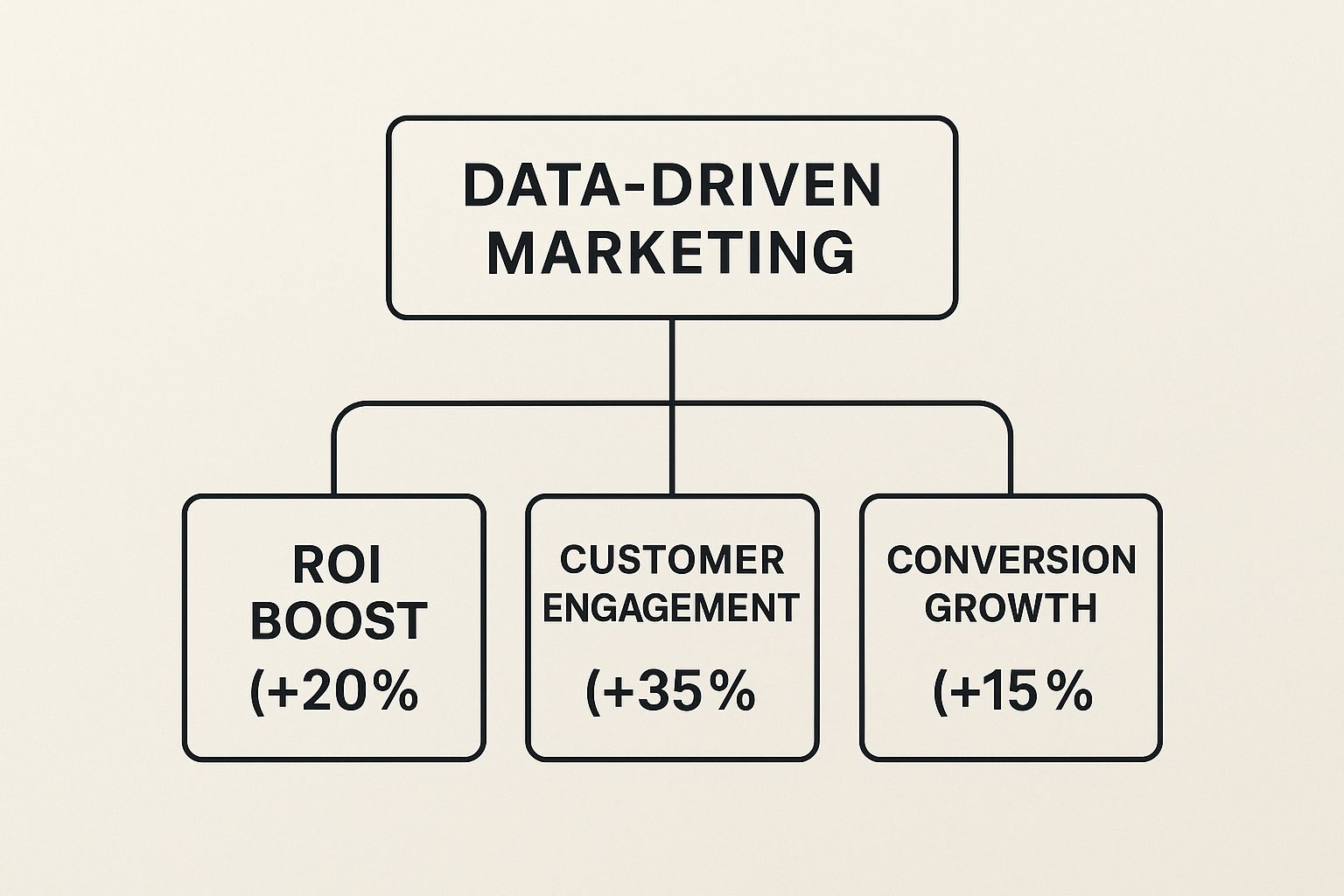Data-driven marketing solutions are strategies that leverage customer data to craft more personal, timely, and effective campaigns. This approach replaces gut feelings with hard facts, allowing businesses to base decisions on actual user behavior. The result is consistently better engagement and a significantly stronger return on investment.
Moving Beyond Guesswork to Data-Driven Marketing

For a long time, marketing felt like an art. Professionals relied on creative instincts and educated guesses, much like a seasoned chef adding a pinch of this and a dash of that. While this might produce a wonderful result once, it's nearly impossible to replicate that success consistently or scale it for a larger audience.
Today, marketing is becoming a precise science. The shift to data-driven marketing is like that same chef finally documenting the recipe. Every ingredient is measured, every step is timed, and the final dish is consistently delicious, whether prepared for two people or two hundred. This isn't a fleeting trend; it’s a fundamental shift required to compete and grow in the modern marketplace.
Why Data is the New Creative Fuel
When you use real customer data, you stop guessing and start knowing. Instead of creating a compelling ad and hoping the right people see it, you know exactly who to target, what to say, and where to deliver your message. This clarity provides a significant competitive advantage.
- Truly Know Your Customers: Data reveals the why behind consumer actions—from the pages they linger on to the final trigger that prompts a purchase.
- Create Experiences That Resonate: You can shape messages that speak directly to an individual's needs or interests, making your brand feel less like a corporation and more like a trusted advisor.
- Optimize Your Spending: Your budget is allocated to the channels and campaigns that are demonstrably working, eliminating waste and maximizing every dollar spent.
How This Changes Business Today
Powered by advanced analytics and AI, data-driven marketing is transforming how companies operate. The proof is in the results. Recent studies indicate that 32% of business leaders already consider their data-first strategies a major success.
Notably, 47% identify email marketing as a prime channel for data application, showcasing its enduring power. You can explore how companies are leveraging these tactics in these data-driven marketing findings.
By grounding your strategy in concrete data, you eliminate guesswork and build a marketing engine that not only performs but continuously improves.
This change in mindset creates a powerful feedback loop. Every campaign becomes a learning opportunity, ensuring your marketing efforts grow smarter and more effective over time.
How to Build Your Data-Driven Marketing Engine
An effective data-driven marketing strategy is more than a collection of software—it’s a finely tuned engine. Think of it as a high-performance race car where every component, from the fuel injectors to the transmission, must work in perfect sync to generate speed and power. Your marketing engine functions similarly, turning raw data into measurable results.
To get this engine running smoothly, you need four key pillars. Each one manages a critical part of the process, ensuring information flows seamlessly from its source to a live campaign. When these pieces are connected correctly, you create a powerful system that drives your marketing with incredible precision.
Pillar 1: Data Collection and Integration
Every data journey begins with gathering the raw materials. This is the fuel for your engine, and it comes from every touchpoint where a customer interacts with your brand. The best data-driven marketing solutions pull information from a wide range of sources to build a complete customer profile.
Common sources include:
- Customer Relationship Management (CRM) Systems: This is your repository of direct customer interactions, purchase histories, and support tickets.
- Web and App Analytics: Tools like Google Analytics provide a window into user behavior—what pages they visit, how long they stay, and the paths that lead to conversion.
- Social Media Platforms: By monitoring conversations and tracking engagement, you can uncover customer sentiment, emerging trends, and direct feedback.
The real value emerges when you integrate these disparate data streams. The objective is to break down silos that trap valuable information, creating a single, unified view of each customer.
Pillar 2: Data Management and Storage
Once you have the data, you need an organized, accessible place to store it. This pillar functions like your engine's central computer, managing and structuring all the information for easy access and analysis. Neglecting this step results in a "data swamp" that is more confusing than helpful.
A Customer Data Platform (CDP) is often the key technology here. It acts as a central hub, ingesting customer data from all your sources, cleaning it for accuracy, and building detailed, unified customer profiles. It's no wonder that businesses with well-managed data strategies drive five to eight times the ROI of their peers.
Pillar 3: Data Analysis and Insights
This is where raw data is transformed into actionable intelligence. Think of this pillar as your engine's diagnostic system—it interprets signals to tell you what’s happening, why it’s happening, and what you should do next. It’s all about finding the meaningful patterns hidden within the numbers.
Here, data analysts and AI-powered tools dig into the organized data to:
- Identify customer segments with shared behaviors.
- Pinpoint the most effective marketing channels and messages.
- Predict future customer needs and market trends.
The real objective isn’t just to review past performance. It’s about generating forward-looking insights that guide your next move, turning historical data into a strategic roadmap.
This process has a direct and powerful impact on the metrics that matter most to your business.

As this demonstrates, a well-oiled data engine doesn't just improve efficiency—it delivers substantial growth in ROI, customer engagement, and conversions.
Pillar 4: Activation and Execution
Finally, this is where strategy becomes action. The activation pillar takes all your hard-won insights and puts them to work through highly targeted and personalized marketing campaigns. It’s the drivetrain of your engine, delivering power to the wheels and propelling your business forward.
With the intelligence you've gathered, you can execute with precision. This could mean sending a personalized email to a specific customer segment, launching a retargeting ad campaign for shoppers who abandoned their carts, or tailoring your website’s content to a visitor's known interests. This final step closes the loop, turning data-backed strategy into real-world marketing that connects with customers.
To bring it all together, here’s a look at how these four pillars function as a cohesive system.
The Four Pillars of Data Driven Marketing Solutions
This table breaks down the key components and functions within a typical data-driven marketing workflow, from initial data collection to campaign activation.
Each pillar builds on the last, creating a cycle where every campaign generates new data, which in turn fuels even smarter insights for the next one.
How AI Is Supercharging Modern Marketing

If data is the fuel for your marketing engine, think of artificial intelligence (AI) as its turbocharger. AI enhances the power of your data, making your efforts exponentially more efficient. It is not a replacement for skilled marketers; rather, it is a powerful tool that helps them cut through the noise, spot hidden patterns, and make smarter decisions, faster.
Imagine trying to understand your customers by manually sifting through thousands of spreadsheets—it’s an almost impossible task. AI, in contrast, can analyze vast datasets in seconds, identify every unique variable, and group them by relevant attributes. That is the transformative power behind modern data-driven marketing solutions.
Predictive Analytics: Seeing What's Coming Next
One of the biggest game-changers AI brings is predictive analytics. Instead of only looking at past performance, this technology helps forecast future outcomes. By analyzing historical data, AI models can detect subtle cues that predict future behavior, such as identifying a customer who is at risk of churning.
For example, an AI might learn that customers who reduce their login frequency by 20% and stop opening marketing emails are 85% more likely to cancel their subscription in the next 30 days. Armed with that knowledge, you can proactively launch a targeted retention campaign with a special offer, preventing churn before it happens.
This shifts your approach from reactive damage control to proactive, strategic moves that protect revenue.
Hyper-Personalization That Actually Feels Personal
Traditional marketing segments audiences into broad categories like age or location. While a useful starting point, it lacks precision. AI drills down much deeper, creating dynamic, hyper-targeted segments based on thousands of real-time behavioral data points.
The result is a far more nuanced understanding of your audience. Instead of targeting "women aged 30-40 who bought running shoes," AI can pinpoint a micro-segment like, "women aged 32-36 who run three times a week, prefer trails, follow nutrition influencers, and are actively browsing for high-performance gear."
By understanding customers on such a granular level, AI allows you to craft messages that are so relevant they feel as though they were written just for them. This is what drives genuine engagement and boosts conversions.
This level of detail makes every touchpoint matter. Knowing precisely what each subscriber is interested in makes it far easier to create a winning email marketing campaign that people actually want to open. This is a hallmark of effective data-driven marketing solutions. Find out more in our guide on how to create a winning email marketing campaign.
Real-Time Campaign Optimization on Autopilot
The digital advertising landscape moves quickly, and campaign performance can shift in an instant. AI and machine learning algorithms can monitor your campaigns 24/7, making automatic adjustments to maximize the value of your ad spend.
Consider an ad campaign running across multiple platforms. An AI system can:
- Shift Budget Automatically: If it detects that Instagram ads are outperforming Facebook ads, it can instantly reallocate the budget to capitalize on the momentum.
- Optimize Bidding Strategies: The algorithm adjusts ad bids in real-time based on the likelihood of a conversion, ensuring you never overpay for a click.
- Test Creative on the Fly: It can rapidly A/B test thousands of combinations of ad copy, images, and headlines to discover what resonates with different audience segments.
This continuous, automated optimization ensures your marketing budget is always working as efficiently as possible. It’s no surprise the global AI marketing market, valued at $20 billion in 2022, is projected to hit $40 billion by 2025, demonstrating how essential these tools are becoming.
Using Social Media Data to Understand Your Audience
Social media is no longer just a broadcast channel. It has evolved into a massive, real-time focus group where your customers openly share their thoughts, desires, and frustrations. For any business, these platforms are a goldmine of genuine customer insight, ready to be used ethically to build more effective marketing.
The key is to look beyond simple vanity metrics like follower counts. While a large audience is beneficial, the real value is hidden in engagement data. A smart data driven marketing solutions strategy delves into likes, shares, and especially comments to understand the why behind audience behavior.
Uncovering Insights with Social Listening
This is where social listening proves invaluable. It is the practice of tracking conversations across the digital landscape to see what people are saying about your brand, your competitors, and your industry. It allows you to gauge brand sentiment, spot emerging trends, and identify customer pain points that might not be communicated through direct channels.
For example, you might notice a sudden spike in mentions about a product feature that users find confusing. That is direct, actionable feedback. You can use it to create a tutorial video or pass it along to your product team for a future update.
The goal is to shift from passively collecting data to actively gathering intelligence. Every comment, tag, and direct message is a clue that helps you build a clearer picture of what your audience truly wants.
This qualitative intelligence fuels smarter, more empathetic marketing by closing the gap between what you think your customers want and what they actually need.
From Engagement Data to Rich Customer Personas
The data you gather from platforms like LinkedIn, Facebook, and TikTok is ideal for building incredibly detailed customer personas. These are not generic avatars but data-backed profiles that capture the real interests, behaviors, and motivations of your target audience.
By analyzing data from different platforms, you can create a much richer profile:
- LinkedIn Data: Perfect for B2B, this reveals professional interests, industry pain points, and key decision-makers.
- Facebook & Instagram Data: This uncovers personal interests, lifestyle habits, brand affinities, and content consumption patterns.
- TikTok & YouTube Data: This highlights trending topics, popular video styles, and the entertainment or educational content that captures attention.
Armed with this detail, you can sharpen your ad targeting and content strategy with surgical precision. It enables you to create campaigns that speak directly to different audience segments, ensuring your message resonates every time. This is a fundamental part of any successful data driven marketing solutions approach.
Translating Social Signals into Business Strategy
The sheer scale of social media makes it impossible to ignore. By 2025, an estimated 5.24 billion people—roughly 64% of the world's population—will be on social networks, using an average of seven different platforms. This is why about 91% of companies now use social media in their marketing. For B2B companies, LinkedIn is a dominant force, with 40% of marketers calling it their most effective channel for generating high-quality leads. You can find more fascinating numbers in these digital marketing statistics.
Ultimately, every social media interaction is a data point. A surge in positive comments indicates your content resonated. A cluster of questions about your shipping policy reveals a gap in your FAQ page. By systematically analyzing these signals, you create a feedback loop that makes your marketing smarter and more aligned with your customers over time.
A Practical Framework for Your Data-Driven Strategy

Discussing data in theory is one thing; putting it into practice is another. The most effective data-driven marketing solutions are not built on chance but on a solid, repeatable framework. Think of it as a playbook that turns abstract numbers into tangible business growth.
Without a structured approach, it is easy to get lost in the data. This framework serves as your roadmap—a five-stage process designed to guide you from setting clear goals to continuous improvement. It ensures every decision is intentional and moves you closer to your objectives.
Stage 1: Define Clear Business Objectives
Before looking at any data, you must define what you are trying to achieve. A strategy without a clear destination is ineffective. Your goals must be specific, measurable, and directly tied to business outcomes—not just vanity metrics.
For example, instead of a vague goal like "increase website traffic," a data-driven objective would be, "Increase marketing qualified leads (MQLs) from organic search by 15% in the next quarter." This clarity dictates exactly which data points require your attention.
These objectives become the north star for your entire strategy, keeping every subsequent step focused on delivering tangible value.
Stage 2: Conduct a Thorough Data Audit
Once your goals are set, it’s time to take stock of your existing data. A data audit is an inventory of your information assets. The goal is simple: map out what data you currently have versus what data you need to achieve your objectives.
This involves asking critical questions:
- What data sources do we have? (e.g., CRM, web analytics, social media insights)
- Is our data accurate and clean? (Poor quality data leads to poor decisions.)
- Where are the gaps? (What crucial information are we missing?)
- How does data flow between our systems? (Are our platforms properly integrated?)
It’s no surprise that 87% of marketers feel data is their company's most underutilized asset. An audit helps you identify and fix these gaps, which is a critical first step.
Stage 3: Select the Right Technology Stack
Your technology stack is the engine that powers your data strategy. The tools you choose should support your goals, not the other way around. While it's easy to be tempted by flashy features, the best tech stack is one that seamlessly supports your specific workflow.
The goal isn't to have the most tools; it’s to have the right tools working in harmony. A well-integrated stack breaks down data silos and provides your team with a single source of truth.
A solid stack typically includes a CRM for customer data, a CDP to unify profiles, analytics platforms for generating insights, and automation tools to execute campaigns. When these systems are well-integrated, information flows smoothly from collection to activation.
Stage 4: Build a Culture of Experimentation
Data provides a starting point, but experimentation validates your hypotheses. The most successful data-driven companies foster a culture where testing and learning are part of the daily routine. It's essential to move away from the pressure of every campaign being a guaranteed success and instead embrace calculated risks.
This means systematically A/B testing everything—from email subject lines and ad creative to landing page layouts. The iterative process of testing, learning, and adapting is what separates good marketers from great ones. For more inspiration, check out our list of 10 data-driven marketing strategies you can start testing today.
Stage 5: Measure, Analyze, and Iterate
Finally, a data-driven strategy is never "finished." It’s a continuous feedback loop where you measure performance, analyze the results, and use that knowledge to improve. This is where you connect your campaign outcomes directly back to the business objectives defined in stage one.
This cycle is straightforward:
- Measure Key Metrics: Monitor the KPIs you defined at the outset.
- Analyze Performance: Look beyond what happened to understand why it happened.
- Iterate for Improvement: Apply your insights to the next campaign.
This loop ensures your marketing becomes progressively smarter and more efficient. Every campaign is an opportunity to learn, refine your approach, and steadily increase your ROI.
Got Questions About Data-Driven Marketing? We've Got Answers.
Embarking on a data-driven marketing journey can seem daunting. Even with a solid plan, practical questions often arise. How do you handle customer information responsibly? How do you measure success effectively?
These are common and important considerations. Here, we address some of the most frequent questions to provide clarity and help you move forward with confidence. Think of this as your practical FAQ for putting data driven marketing solutions to work.
How Can We Use Data While Respecting Customer Privacy?
This is a critical question. In today's landscape, using data ethically is not just a regulatory requirement—it is the foundation of customer trust. The best approach is to shift from being a data collector to a data steward. You are the guardian of your customers' information, and your actions should reflect that responsibility.
To achieve this, focus on three core principles:
- Transparency: Be upfront and clear about what data you are collecting and why. Your privacy policy should be easily understandable to the average person, not just a lawyer.
- Consent: Always obtain explicit consent before tracking or using personal data. This means no pre-checked boxes or confusing language designed to trick users into opting in.
- Value Exchange: Ensure you offer something genuinely useful in return for the data, such as more relevant content, personalized offers, or a smoother user experience.
Complying with regulations like GDPR and CCPA is the starting point, not the finish line. The ultimate goal is to build a relationship where customers feel safe and respected. That trust is more valuable than any single data point.
What Are the Most Important Metrics to Track?
It is easy to get lost in a sea of data. The key is to focus on the metrics that are directly tied to your business objectives. "Vanity metrics" like social media likes may be encouraging, but they often fail to reflect the bottom line.
Instead, concentrate on key performance indicators (KPIs) that demonstrate tangible business impact. For most businesses, these include:
- Customer Acquisition Cost (CAC): How much does it cost to acquire a new customer from a specific campaign?
- Customer Lifetime Value (CLV): What is the total projected profit from a customer over their entire relationship with your brand?
- Conversion Rate: What percentage of users are completing a desired action, such as making a purchase, filling out a form, or subscribing to a newsletter?
The real insight comes from analyzing how these metrics interact. A low CAC is good, but it’s exceptional when paired with a high CLV.
This sharp focus on business outcomes is what distinguishes a truly effective data-driven strategy from one that merely generates reports. For a deeper analysis, see our guide on evaluating ROI in digital marketing.
Can We Do This on a Small Budget?
Absolutely. You do not need an enterprise-level budget to start making data-informed decisions. The key is to start small, focus on high-impact areas, and scale your efforts as you see positive results.
Here’s a practical plan to get started:
- Master Google Analytics: This free tool is incredibly powerful. Before investing in other platforms, learn the ins and outs of how users find and interact with your website.
- Dig into Your CRM: Your customer relationship management system is a goldmine of first-party data. Analyze purchase histories and customer interactions to identify easy opportunities for segmentation.
- Pick One Channel: Don't try to do everything at once. Choose a single channel, like email marketing, and focus your data efforts on improving its performance. A few small, data-backed tweaks can have a significant impact.
The initial investment is not just financial—it's a commitment of time to learning and experimenting. Once you prove the value of this approach on a small scale, it becomes much easier to justify a larger investment in resources. The key is to be strategic with what you already have.
Ready to stop guessing and start implementing data driven marketing solutions that deliver measurable results? The team at Twelverays specializes in building strategies that fuel real growth. Contact us today to learn how we can help you unlock the full potential of your data.





